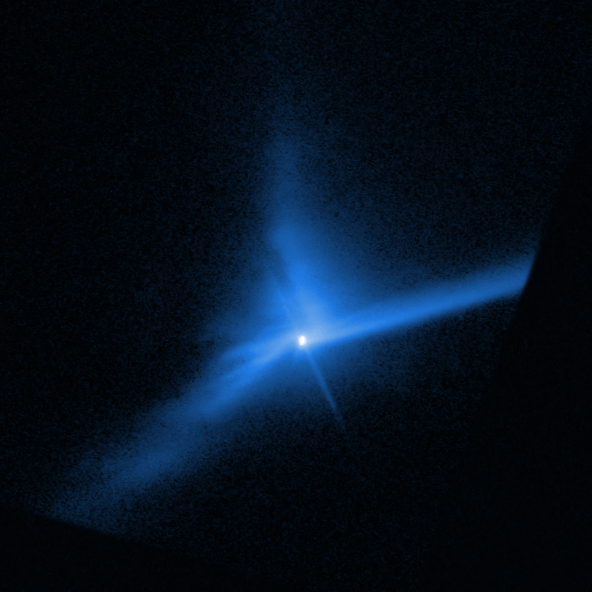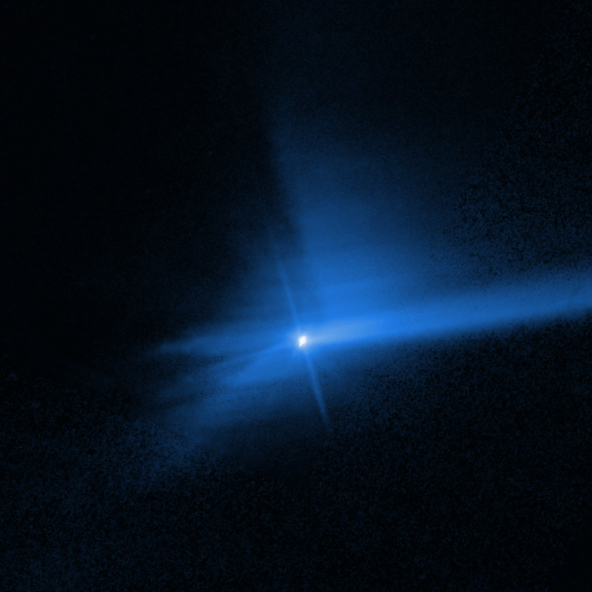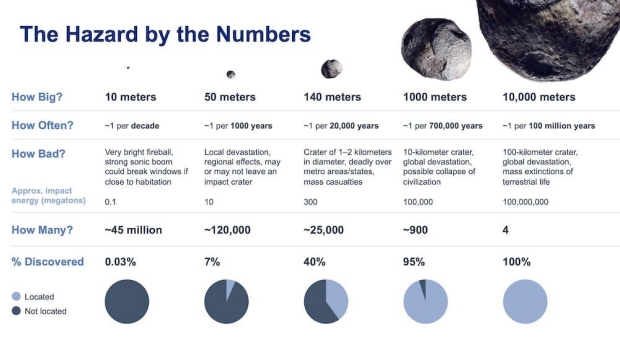I’m glad to see the widespread coverage of the DART mission results, both in terms of demonstrating to the public what is possible in terms of asteroid threat mitigation, and also of calming overblown fears that we have too little knowledge of where these objects are located. DART (Double Asteroid Redirection Test) was a surprisingly demonstrative success, shortening the orbit of the satellite asteroid Dimorphos by an unexpectedly large value of 33 minutes. The recoil effect from the ejection of asteroid material, perhaps as high as 0.5% of its total mass, accounts for the result.
Watching the ejecta evolve has been fascinating in its own right, as the interactions between the two elements of the binary asteroid come into play along with solar radiation pressure. Asteroids have previously been observed that displayed a sustained tail, as Dimorphos did after impact, and the DART results suggest that the hypothesis of similar impacts on these objects is correct. Thus we learn valuable lessons about how asteroids behave when impacted either by technologies or by natural objects. We can expect the study of ‘active asteroids’ to get a boost from the success of this mission.
The two images below are from the Hubble instrument, which observed the development of Dimorphos’ tail. Jian-Yang Li (Planetary Science Institute) is lead author of a recent paper in Nature on the evolution of the ejecta. Li comments on the interplay between the gravity of Dimorphos and parent asteroid Didymos as well as the pressure of sunlight in the first two and a half weeks after the impact. Bear in mind that an impact on a single as opposed to a binary asteroid would not display such complex effects. The presence of Didymos was indeed useful:
“A simple way to visualize the evolution of the ejecta is to imagine a cone-shaped ejecta curtain coming out from Dimorphos, which is orbiting Didymos. After about a day, the base of the cone is slowly distorted by the gravity of Didymos first, forming a curved or twisted funnel in two to three days. In the meantime, the pressure from sunlight constantly pushes the dust in the ejecta towards the opposite direction of the Sun, and slowly modifies and finally destroys the cone shape. This effect becomes apparent after about three days. Because small particles are pushed faster than large particles, the ejecta was stretched towards the anti-solar direction, forming streaks in the ejecta.”

Image: Ejecta from Dimorphos 4.7 days (above) and 8.8 days (below) after impact, taken on October 1 and October 5, 2022, respectively. The Sun is at the 8 o’clock direction. The ejecta is pushed by the sunlight towards the 2 o’clock direction and increasingly stretched to form streaks. Credit: NASA, ESA, STScI, Jian-Yang Li (PSI), Image Processing: Joseph DePasquale.

So we’ve learned that slamming a 570 kilogram spacecraft into this type of asteroid at something over 22,000 kilometers per hour can alter its orbital speed. Data from the Light Italian CubeSat for Imaging of Asteroids (LICIACube) is part of the current analysis, while we’ll learn yet more about the effects of the impact from the European Space Agency’s Hera mission, which will survey both Didymos and Diomorphos, focusing on the crater left by DART and the changes to the mass of the impacted asteroid.
The matter of locating those hazardous asteroids that have yet to be identified is now highlighted by what we can consider the next planetary defense mission, the Near-Earth Object Surveyor, planned for a 2028 launch. The mission will carry a 50 centimeter diameter telescope operating at two infrared wavelengths, conducting a multi-year survey in search of near-Earth objects larger than 140 meters. The goal is to find 90 percent of such objects coming within 48 million kilometers of Earth’s orbit. The observation strategy employed should allow accurate enough determination of asteroid orbits to allow them to be found again and their trajectories tracked.
Image: Near-Earth asteroids and the possibilities of impact. Credit: NASA.
The paper on DART, one of five papers recently published in Nature on the mission, is Jian-Yang Li et al., “Ejecta from the DART-produced active asteroid Dimorphos,” Nature 01 March 2023 (abstract).




Familiarity with the contents of articles concerned the results of the DART mission, which are recently published in the Nature and arXiv, shows the following. Firstly, the key data interpretations and the validity of the conclusions are not convincing without taking into account the results of direct ground-based observations of the collision process and the subsequent ejection of the comparatively large asteroid fragments. Among the published results of such direct observations, the most informative data is contained in a video-animation compiled from a large series of photographs that were obtained using the telescope of the University of Hawaii in South Africa – see the second part of the video around the 50th second:
https://www.youtube.com/watch?v=bfqVqOl9S9w
An analysis of this 500-fold time-compressed video-animation provides evidence that the decrease in the asteroid’s orbital period declared by the authors of the above articles, which follows from photometric observations of mutual occultations-eclipses and radar data, may have an alternative explanation. Specifically, it can be a consequence of geometric-photometric distortions caused by the essential asymmetric increase of the observed Dimorphos`s size, which remained unchanged, while the small-sized component of the wide fan-shaped ejecta continued to move away. Since the brightness and scale of the background stars images did not change, the metamorphosis of the asteroid image cannot be attributed to inaccuracies or errors.This phenomenon is appearance of an asymmetric and optically dense “cloud” of mini-satellites in orbits around Dimorphos, into which relatively larger fragments ejected at lower velocities turned into.
Observations of only two successive occultations-eclipses during Dimorpos orbital semi-period [Thomas et al. 2023] are able to create the illusion of a shortening of its orbital period due to the displacement of the photometric center of the distorting asteroid image relative to its center of mass. Estimates of the orbital period of the “cloud” of mini-satellites located at heights of several tens of meters above the surface of Dimorphos (according to video animation) lead to its values being several times larger than the orbital period of the asteroid itself. Therefore, during these events, about 6 hours separated, the “cloud” of mini-satellites will most of the time be located on different sides of the asteroid, which is moving in opposite visible directions. Fimally, according to estimates, this should manifest as an opposite temporal shift in the positions of the brightness minima. According to estimates the summarized shift will close to the declared decrease in the orbital period of Dimorphos. On the contrary, when using observational data of same type the occultations-eclipses, occurring once during its orbital period, such a relative shift is unlikely, despite the presence of a distorting asymmetry in the visible image of the asteroid.
In addition, the assertion that the ejection was much more efficient in transferring the pushing impulse as compared to the actual impact also raises doubts. According to [Li et al. 2023] and the above video-animation, the mean initial speed of most share of the wide fan-shaped ejection, was around several cm/s or less. Therefore, with an estimated the total ejecta mass of up to 1 million kg., its momentum was comparable with the impactor`s one. Moreover, it is clear that only a small area near the impact direction (i.e. close to the axis of the ejection cone) can be effective for act an asteroid. At the same time, the rest of the ejecta regions compensated each other out significantly in the respect to impulse transfer abilities, which is problematic in itself on the totally inelastic collision with the loose rubble pile asteroid.
In summary, for now the success of this generally complex and beautiful space experiment can be considered as questionable in terms of the main stated goals.
@Victor – can you add the links to the papers that you have used to contradict the Jian-Yang Li et al paper in Nature?
That Nature paper is paywalled … even though it is essentially a preprint. The original paper is at https://arxiv.org/ftp/arxiv/papers/2303/2303.01700.pdf I wish people would recognize the free preprint as the true paper, the director’s cut, and say a paper isn’t even published (as in public) if people can’t read it. It’s easier to do critical thinking than to pay for all the journals in the world.
The Doppler data for the orbit of Dimorphos is seen in https://arxiv.org/ftp/arxiv/papers/2303/2303.02077.pdf Figure 2. I can’t imagine another explanation. The “momentum enhancement” is indeed dramatic (33 minutes change rather than 7); this is not your average traffic accident!
Papers that contradicted the [Jian-Yang Li et al.] are not yet exist. On the other hand, this is perhaps the only paper (of the recently published as preprints) that provides specific data on the separate ejecta component parameters (see «Extended Data Table 2» there). The remaining two papers (see links below) devoted to momentum transfer do not even contain rough estimates of the everage velocity of total ejection (not to mention the dilution of the ejection efficiency with distance from its axis…), which makes the conclusions unsubstantiated.
As for the rest articles (see Mike Serfas reply), it looks like nature played a “cruel joke” with observers who used the only two mutual occultations-eclipses of Didymos and Dimorphos to determine of its orbit changes.
https://arxiv.org/abs/2303.03464
https://arxiv.org/abs/2303.02248
I followed what u said as best I could; but didn’t they make that period shorting annoc. just 1 day after the collision – before what u described above happened ?
Now for an atomic test.
Asteroids are all different; size, mass, density, composition. And their orbits relative to earth vary enormously. No single test is going to tell us anything–except perhaps how THAT particular asteroid is going to react to whatever method we user to move, destroy, deflect, etc.
The only planetary defense program that makes any sense is to identify every potential asteroid collision we can, prioritize them by their potential damage and time till impact, and then study each one intensely to find out which plan will be most effective against each one.
In each case, the more time we have to plan, the better. And the more we know about every potential hazard, the better. And of course, he situation is possibly much more complex than that. For example, we may determine that some particular rock will never come close enough to earth to hit us, but we must also make sure it will not interact with some other body in the future that night perturb its orbit and turn it into a killer.
I suspect the project will be immense, and it will never be completely effective. Only the worst threats will be identified soon enough for us to do anything about them, but many others, perhaps of lesser damage potential , will slip through our defenses.
Planet-busters will be few, and easy to identify, but will require lots of lead time and very high tech to protect against. City busters will be more numerous, harder to spot, but easier to defend against once identified.
There’s a lot we can do to protect the planet, but there are no guarantees.
Perhaps a firstlight design could work, we fire these fuel cubes at very high velocity to hit the asteroid causing fusion, we would need around 70 km km/s to induce fusion in the cube. A tall order though having said that.
https://www.oxfordcc.co.uk/custom-software/first-light-fusion/